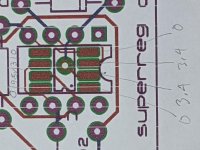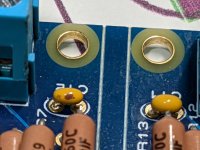You don't need any pre-regulator in my view.
Jan
Initially I plan to use a rechargeable battery as a DC source for the Superreg: 8 AA Eneloop Panasinic cells for the +5V 250mA output. A single charge should last for 4-6 hours feeding a DAC with a clean USB power. The input voltage will be gradually dropping from 13V to 10V.
Other than a periodic recharging, is there any technical or sonic disadvantage in this approach?
I think this is a very good solution. Maybe you can combine the on-off switch with switching the battery from 'use' to 'charge'. That way you don't have to worry about charging etc.
Jan
Jan
Salas
Dear Jan,
Preliminary thoughts
Like some others I would like to build a well sounding regulator.
I would use it for my RIAA and for my DAC (strongly modded 9038PRO).
(RIAA is in progress, DAC, is working)
Earlier i preferred the SALAS shunt reg idea, therefor for the DAC I built the v1.3 - which seems much better than the v1.1.
I've just read the article by John Walton, which compares several regulators where the Salas was not that nice performing on the listening test.
My questions - 1 - sound
Just to be able to judge what I can accept in sound performance increase - how do you see your v2.3 comparing to salas v1.3?
(with other words - does it worth to put energy to build the superreg - may I expect better sound?)
2 - Opa
OPA825 seems quite expensive even on Mouser, Is there a good substitution for that what is much more cheaper? - in DAC, I realized the huge difference in sound quality NE5532 - OPA2134 - LM49720 - bipolar OPA,
I suppose the same valid here, so I wouldn't apply NE5534 🙂.
(and shockingly the CAPs has a very very strong effect on the voice too - ELNA silmic vs Nichicon muse vs traditional)
Thanks in advance,
Szabolcs
Dear Jan,
Preliminary thoughts
Like some others I would like to build a well sounding regulator.
I would use it for my RIAA and for my DAC (strongly modded 9038PRO).
(RIAA is in progress, DAC, is working)
Earlier i preferred the SALAS shunt reg idea, therefor for the DAC I built the v1.3 - which seems much better than the v1.1.
I've just read the article by John Walton, which compares several regulators where the Salas was not that nice performing on the listening test.
My questions - 1 - sound
Just to be able to judge what I can accept in sound performance increase - how do you see your v2.3 comparing to salas v1.3?
(with other words - does it worth to put energy to build the superreg - may I expect better sound?)
2 - Opa
OPA825 seems quite expensive even on Mouser, Is there a good substitution for that what is much more cheaper? - in DAC, I realized the huge difference in sound quality NE5532 - OPA2134 - LM49720 - bipolar OPA,
I suppose the same valid here, so I wouldn't apply NE5534 🙂.
(and shockingly the CAPs has a very very strong effect on the voice too - ELNA silmic vs Nichicon muse vs traditional)
Thanks in advance,
Szabolcs
I have not done the extensive listening tests Jack did so I have to refer you to those that you already mentioned.
As to the opamp, I believe you meant AD825, not OPA825? There is extremely little sound difference from the opamp type, as you can read in the article by Jack.
The preference for the AD825 comes from the use in 100's of regulators without any issues with stability. This is important because very few diy'ers will be able to recognize and fix instability in the regulator.
That said, I know there are many users that used other opamps with success, but I have no direct experience so cannot really comment. And the AD825 is not that expensive compared with the rest of your system!.
Jan
As to the opamp, I believe you meant AD825, not OPA825? There is extremely little sound difference from the opamp type, as you can read in the article by Jack.
The preference for the AD825 comes from the use in 100's of regulators without any issues with stability. This is important because very few diy'ers will be able to recognize and fix instability in the regulator.
That said, I know there are many users that used other opamps with success, but I have no direct experience so cannot really comment. And the AD825 is not that expensive compared with the rest of your system!.
Jan
I think this is a very good solution. Maybe you can combine the on-off switch with switching the battery from 'use' to 'charge'. That way you don't have to worry about charging etc.
Jan
Great suggestion, thank you! Eneloops are charged by a microchip controlled smart Panasonic charger. On the inside it is just a circuit board. I will take two of them as is and just add switches and individual battery holders. This seems very doable for the +5V version.
AA cells won’t work for the +/-18V version. Perhaps an AC transformer or higher voltage batteries. May be lithium iron phosphate or lithium cobalt oxide.
There are some 'smart' Powerbanks out there that can supply 21V IIRC.
They can be re-charged from a standard USB charger.
Jan
They can be re-charged from a standard USB charger.
Jan
Well, it's built. Goal was to get 18V. I used 1k for R6,13 and 620 for R14 and R7. I got 19V output on both + and -. I'm hoping to use it for Wayne's BA 2018 Preamp, so these values are fine. Linear supply at 24V. Then I accidently shorted the + of my linear supply to ground. SuperReg was not attached at the time. After replacing the damage parts on the Linear supply, I retested. Linear supply again reads 24V on both + and -.
However, while Neg output on the SuperReg is still at 19V, the Pos is at 9.64V
I changed R6 and R7 to both be 1000R and I get 9.86V
I cleaned the board again and reflowed solder on all connections, same result.
For all measurements, the Pos Volt out Sense is shorted to Pos Volt Out, same for the return.
Any suggestions on where to start?
Thanks in advance!
However, while Neg output on the SuperReg is still at 19V, the Pos is at 9.64V
I changed R6 and R7 to both be 1000R and I get 9.86V
I cleaned the board again and reflowed solder on all connections, same result.
For all measurements, the Pos Volt out Sense is shorted to Pos Volt Out, same for the return.
Any suggestions on where to start?
Thanks in advance!
Last edited:
Voltages to ground at each pin of opamp.
So, the opamp works OK, the two inputs are equal.
Check the reference diode on pin 3, as well as the resistor feeding it. That reference should be nominal 6.9V (assuming you used a '329).
Jan
I have a separate case for my preamp power supply. Is this regulator best put in the preamp case? Thanks!
Conventional wisdom would locate a conventional regulator right next to the circuit being powered... inside the signal box.
With its integral sense function this regulator should work at some distance from the circuit.
Whether or not that extends to a PSU box 6 feet or so away... is an interesting question.
With its integral sense function this regulator should work at some distance from the circuit.
Whether or not that extends to a PSU box 6 feet or so away... is an interesting question.
Agreed, I would place the superreg in the same box as the circuit to be powered, as close as feasible. The sense connections help but close is best.
The transformer, rectifiers, capacitors can be placed in a separate enclosure if you want, that is less critical.
Jan
The transformer, rectifiers, capacitors can be placed in a separate enclosure if you want, that is less critical.
Jan
Thanks for the suggestions! Once I get the positive supply troubleshot, I'll be dropping it in!
I remember in the good old (TAA) days Richard Marsh, in his preamp articles, described "low Z" wiring to preserve whatever regulation was created by the PSU: flattened wires taped to the chassis with thin insulation between.
I always assumed that the sense feature of the Super Regulators was mostly intended to make the nature of the wiring between regulator and circuit less critical.
What was interesting about the question was the suggestion that, perhaps, the sense wires could do more... like allow the regulation to be located remotely (not that that makes "sense" to me -- pardon the pun).
What are the limitations of the sensing function?
I always assumed that the sense feature of the Super Regulators was mostly intended to make the nature of the wiring between regulator and circuit less critical.
What was interesting about the question was the suggestion that, perhaps, the sense wires could do more... like allow the regulation to be located remotely (not that that makes "sense" to me -- pardon the pun).
What are the limitations of the sensing function?
Yes that is exactly what they do, sense the output voltage remotely, so that the regulation takes place right at the load. That takes out the resistance and induction of the connecting wire.
The limitation is that the sense wiring itself has an induction and possibly a parasitic capacitance that can impact the regulator stability. That's why the RC is there on the sense line.
I haven't tested it on longer distances like placing it in a separate enclosure and running the wiring through an umbilical cable.
But, at any rate, there is absolutely no advantage in placing the regulator in a separate enclosure, only disadvantages.
Jan
The limitation is that the sense wiring itself has an induction and possibly a parasitic capacitance that can impact the regulator stability. That's why the RC is there on the sense line.
I haven't tested it on longer distances like placing it in a separate enclosure and running the wiring through an umbilical cable.
But, at any rate, there is absolutely no advantage in placing the regulator in a separate enclosure, only disadvantages.
Jan
I am building an RIAA circuit that uses 3 dual op amps. The last one I hope!
I have 2 questions.
1. Does it make sense to use an RC filter between the Super Reg and the power input pins of the op amp and still use the sense circuit? The RC will provide less ripple but it will degrade the impedance of the power. Which is the correct tradeoff?
2. While it might be overkill and since it is the last RIAA I will build, is there any potential benefit to power each op amp with its own Super Reg?
I hope the experienced circuit designers can chime in and help in this regard.
Thanks.
I have 2 questions.
1. Does it make sense to use an RC filter between the Super Reg and the power input pins of the op amp and still use the sense circuit? The RC will provide less ripple but it will degrade the impedance of the power. Which is the correct tradeoff?
2. While it might be overkill and since it is the last RIAA I will build, is there any potential benefit to power each op amp with its own Super Reg?
I hope the experienced circuit designers can chime in and help in this regard.
Thanks.
Last edited:
- Home
- The diyAudio Store
- Super Regulator

